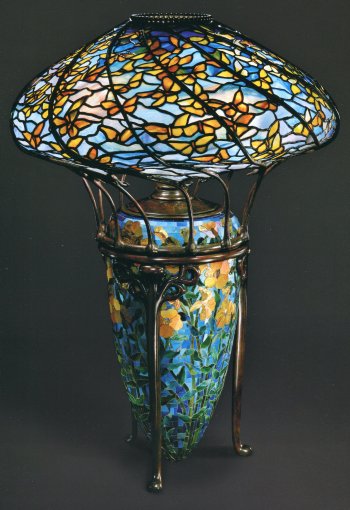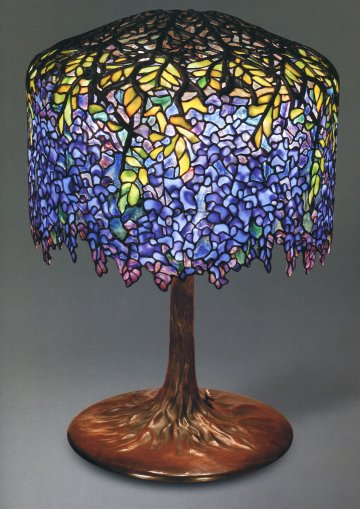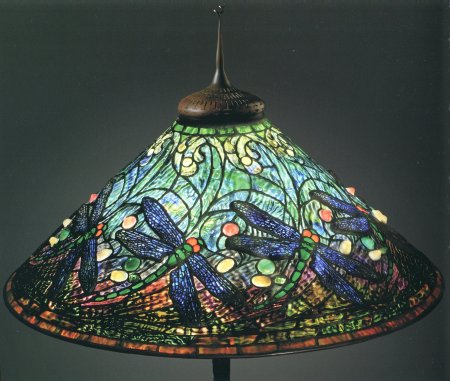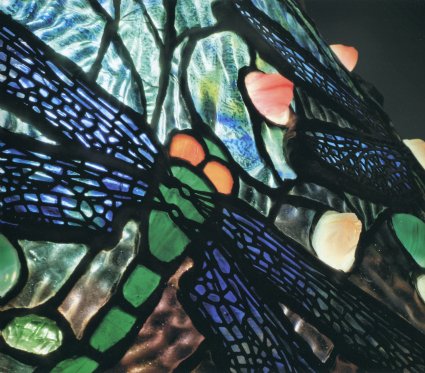|
|
|
|

|
|

|
|
|
|
|
|
|
|
What saved Clara Driscoll from obscurity is not any Tiffany Studios catalog, but her passion for writing letters. Writing at least once a week, often twice a week during her career from 1888 to 1908 or 1909 at Tiffany Studios, and averaging at least a dozen pages each, she addressed her letters, "Dear Ones," knowing they would be passed from her mother in Tallmadge, Ohio to her three sisters and her aunt, all of whom would add commentary as it moved along. These came to be affectionately known as the Round Robin letters. They revealed not only her professional and artistic activities, but her news of social events like the Tiffany Balls and her weekends spent with friends at a beach cottage at Point Pleasant, New Jersey, as well as cultural events in New York, notably theater, symphony concerts, and opera. According to Linda Ferber, Vice President and Museum Director of the New York Historical Society, the institution mounting the first exhibit about Clara Driscoll and the Tiffany Girls in 2005, "[Clara's] vivid descriptions of her work and her colleagues constitute the only known first-person account of the day-to-day activities of Tiffany Studios. This goldmine of information, contained in her letters to her family, has transformed our understanding of the design and manufacture of Tiffany objects, including lamps, windows, and mosaics. Equally important, her account has revealed the crucial role played by women at the firm, identifying many women employees whose significant contributions as artists have gone unacknowledged until now."
Clara's letters have not only been my window to the woman, but my inspiration. Here is a sampling.
QHS after the passage indicates that the letter is owned by the Queens Historical Society, Flushing, NY. KHM indicates ownership by Kelso House Museum, Kent, Ohio, and housed in the Special Collections of Kent State University Library. I'm grateful to both owning institutions for permission to post the following passages.
June 22, 1898 It is quite a pretty walk by Gramercy Park and the Players Club and some fine old residences on the upper end of Irving Place. There are several trees on the way, one in front of this house is growing in front of the sidewalk. There is a pretty little back yard with two small trees, some grass and several vines. It is not like real grass but scant spears pricking through the mud. In the evenings George often comes around and we take a walk around the neighborhood squares where there are parks--Union, Madison, Gramercy and Stuyvesant--not all the same evening, though one could and still not have walked quite three miles... My last lampshade was accepted and I am having it made now. It will be quite expensive, but I think it will be attractive and that the general public will admire it. The one before this was a purple and red scheme with opal to lighten and soften it. Mr. Tiffany thought it was very fine and Mr. Mitchell thought it was the ugliest thing he ever saw. Mr. Mitchell said that nobody would buy it. It was peculiar and he thought a very disagreeable color whereas Mr. Tiffany insisted upon having it made, saying the color scheme was both new (for lampshades) and "interesting." He "should not think of having it changed." So you see my designs have not pleased everybody. [QHS] |
|
|
|
|
|

|
|
|
|
Butterfly Lamp, designed by Clara Driscoll, c 1899. Photo: Colin Cooke. The Lamps of Louis Comfort Tiffany, by Martin Eidelberg, et al. |
|
|
|
June 29, 1898 The furnaces were very comfortable-looking coming out of the black damp winter weather. They are in an immense brick and stone room very hot and almost unlighted except for the great shafts of golden light pouring from the open doors, dark and evil-looking men without many clothes on rushing around with long red hot pokers. I quite enjoy going over there... Last and most important... is a big beautiful lamp of the evening primrose, like that field of them on Mr. Roote's land [in Tallmadge, Ohio]. This in mosaic will be the lamp and a cloud of little yellow butterflies which you know look exactly like the primrose blossom, in a network of gold wire made in beautiful lines like the lines of smoke--is to be the shade. I described this to Mr. Tiffany while he was in Mr. Mitchell's office sitting in front of the electric fan in Mr. Mitchell's chair waiting for him to come in, and looking as if life were a burden that he could not support much longer. But when he heard about the primroses, he braced up at once, seized a pencil and began to make pictures all over Mr. Mitchell's clean blotter and talking to himself and to me while the fan made his thick curls stand up around his beaded brow like a halo, after this fashion--"The lamp mutht [sic] be tall and thhin [sic]" (the words tall and thin being unnaturally lengthened while he drew long up and down lines to illustrate, "like the flowereth [sic] and the thade [sic]"--but every time he came to that he wavered off into such vague lines that you could scarcely distinguish them from the gray of the blotter and then he would say, "Well, work out your own idea." [QHS] Aug. 5, 1898 Someday when I am rich I am going to buy a little place down at Point Pleasant...A ride through the woods by the sea and down to the beach before breakfast. The birds were singing and everything was dripping with dew. I found I could swim a short distance and then cold salt water was exhilarating beyond anything I know. A campfire and supper on the beach, watching the double rainbow. A sail on the river by moonlight, and two others in the daytime. A long walk, a long trolley ride by the sea, and a flower gathering trip. We put on our bicycle skirts as soon as we got there and did not exchange them for anything but nightgowns all the time we stayed. [QHS] July 27, 1899 Mr. Tiffany sailed this morning and before he left said that I had great creative ability and he was much pleased with my work. [QHS] |
|
|
|

|
|
|
|
Wisteria Lamp, probably designed by Clara Driscoll with L.C, Tiffany, c 1902. Photo: Colin Cooke. The Lamps of Louis Comfort Tiffany, by Martin Eidelberg, et al. |
|
|
|
Feb. 12, 1902 I have had a production streak and the days have not been long enough to work in. Of course it will not last but I have evolved three really good things in the last week that ought to be a financial as well as an artistic success. Also two more wisteria lamps have sold--that are not yet commenced so we have an order for six more, which makes fifteen in all at $350 each. All of which goes down to my credit, it being my design. I mean to try one more new and original lamp of the expensive class this year, but so far it is vague and worrisome. I have an idea but it is indefinite and I am afraid not as good as the wisteria. I am letting it stay on a shelf in my mind to see if it will grow or 'rot.' [KHM] March 26, 1902 I felt so discouraged and disgusted with my things when I saw theirs, it seemed hardly worthwhile to go on trying, but of course I shall. I realize that I have certain limitations which they do not. Their work is, practically, the private enterprise of a rich man, and they never consider anything but the question of beauty, while I have to consider the cost of production at every step, beside being interrupted in my work by all manner of things relating to business rather than art. But there is this comfort. I can earn more than any of them and that is something. I shall go back to my new little ink bottles and things that I was feeling so proud of. [KHM] |
|
|
|
|
|

|
|
|
|
Dragonfly Flying Round Lamp, designed by Clara Driscoll, c 1906. Art & Architecture Collection, Miriam and Ira D. Wallach Division of Art, Prints and Photographs. The New York Public Library. |
|
|
|
July 30, 1902 Today we got an order for forty more dragon fly [sic] lampshades, twenty conventional peony globes, and five more wisteria lamps. That makes twenty wisteria lamps in all, and as they are my design and sell for $250 apiece, I feel quite pleased. [KHM] |
|
|
|
|
|

|
|
|
|
Dragonfly Flying Round detail, designed by Clara Driscoll, 1906. Art & Architecture Collection, Miriam and Ira D. Wallach Division of Art, Prints and Photographs. The New York Public Library. |
|
|
|
Note: Lamp prices fluctuated according to size, model, and whether or not the base was included. There were two sizes of the Wisteria lamp. |
|
|
|